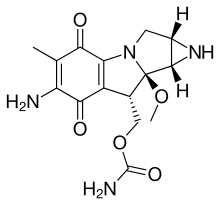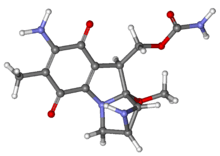Mitomycin C
Mitomycin C is a mitomycin that is used as a chemotherapeutic agent by virtue of its antitumour activity. It is given intravenously to treat upper gastro-intestinal cancers (e.g. esophageal carcinoma), anal cancers, and breast cancers, as well as by bladder instillation for superficial bladder tumours. It causes delayed bone marrow toxicity and therefore it is usually administered at 6-weekly intervals. Prolonged use may result in permanent bone-marrow damage. It may also cause lung fibrosis and renal damage.
 | |
 | |
| Clinical data | |
|---|---|
| Pregnancy category | |
| Legal status | |
| Legal status | |
| Pharmacokinetic data | |
| Metabolism | Hepatic |
| Elimination half-life | 8–48 min |
| Identifiers | |
IUPAC name
| |
| CAS Number | |
| PubChem CID | |
| PubChem SID | |
| IUPHAR/BPS | |
| DrugBank | |
| ChemSpider | |
| UNII | |
| KEGG | |
| ChEBI | |
| ChEMBL | |
| CompTox Dashboard (EPA) | |
| ECHA InfoCard | 100.000.008 |
| Chemical and physical data | |
| Formula | C15H18N4O5 |
| Molar mass | 334.332 g·mol−1 |
| 3D model (JSmol) | |
| Melting point | 360 °C (680 °F) |
| Solubility in water | 8.43 g L−1 mg/mL (20 °C) |
SMILES
| |
InChI
| |
Mitomycin C has also been used topically rather than intravenously in several areas. The first is cancers, particularly bladder cancers and intraperitoneal tumours. It is now well known that a single instillation of this agent within 6 hours of bladder tumor resection can prevent recurrence. The second is in eye surgery where mitomycin C 0.02% is applied topically to prevent scarring during glaucoma filtering surgery and to prevent haze after PRK or LASIK; mitomycin C has also been shown to reduce fibrosis in strabismus surgery.[1] The third is in esophageal and tracheal stenosis where application of mitomycin C onto the mucosa immediately following dilatation will decrease re-stenosis by decreasing the production of fibroblasts and scar tissue.
Mitomycin C is a potent DNA crosslinker. A single crosslink per genome has shown to be effective in killing bacteria. This is accomplished by reductive activation of mitomycin to form a mitosene, which reacts successively via N-alkylation of two DNA bases. Both alkylations are sequence specific for a guanine nucleoside in the sequence 5'-CpG-3'.[2] Potential bis-alkylating heterocylic quinones were synthetised in order to explore their antitumoral activities by bioreductive alkylation.[3] Mitomycin is also used as a chemotherapeutic agent in glaucoma surgery.
In the bacterium Legionella pneumophila, mitomycin C induces competence, a condition necessary for the process of natural transformation that transfers DNA and promotes recombination between cells.[4] Exposure of the fruitfly Drosophila melanogaster to mitomycin C increases recombination during meiosis, a key stage of the sexual cycle.[5] It has been suggested that during sexual process in prokaryotes (transformation) and eukaryotes (meiosis) DNA cross-links and other damages introduced by mitomycin C may be removed by recombinational repair.[6]
Anticancer treatments with chemotherapeutic agents often impair brain cell function leading to memory loss and cognitive dysfunction. In order to understand the basis of these impairments, mice were treated with mitomycin C, a chemotherapeutic agent, and cells of the prefrontal cortex were examined.[7] This treatment resulted in an increase of the oxidative DNA damage 8-oxo-dG, a decrease in the enzyme OGG1 that ordinarily repairs such damage and epigenetic alterations. These alterations at the DNA level may explain, at least in part, the impairments of cognitive function after chemotherapy.[8]
Mitomycin was discovered in the 1950s by Japanese scientists in cultures of the microorganism Streptomyces caespitosus. [2]
References
- Kersey JP, Vivian AJ (Jul–Sep 2008). "Mitomycin and amniotic membrane: a new method of reducing adhesions and fibrosis in strabismus surgery". Strabismus. 16 (3): 116–118. doi:10.1080/09273970802405493. PMID 18788060.
- Tomasz, Maria (September 1995). "Mitomycin C: small, fast and deadly (but very selective)". Chemistry and Biology. 2 (9): 575–579. doi:10.1016/1074-5521(95)90120-5. PMID 9383461.
- Renault, J.; Baron, M; Mailliet, P.; et al. (1981). "Heterocyclic quinones 2. Quinoxaline-5,6-(and 5-8)-diones - Potential antitumoral agents". Eur. J. Med. Chem. 16 (6): 545–550.
- Charpentier X, Kay E, Schneider D, Shuman HA (March 2011). "Antibiotics and UV radiation induce competence for natural transformation in Legionella pneumophila". J. Bacteriol. 193 (5): 1114–21. doi:10.1128/JB.01146-10. PMC 3067580. PMID 21169481.
- Schewe MJ, Suzuki DT, Erasmus U (July 1971). "The genetic effects of mitomycin C in Drosophila melanogaster. II. Induced meiotic recombination". Mutat. Res. 12 (3): 269–79. doi:10.1016/0027-5107(71)90015-7. PMID 5563942.
- Bernstein H, Bernstein C, Michod RE (2012). DNA repair as the primary adaptive function of sex in bacteria and eukaryotes. Chapter 1: pp.1-49 in: DNA Repair: New Research, Sakura Kimura and Sora Shimizu editors. Nova Sci. Publ., Hauppauge, N.Y. ISBN 978-1-62100-808-8 https://www.novapublishers.com/catalog/product_info.php?products_id=31918
- Kovalchuk A, Rodriguez-Juarez R, Ilnytskyy Y, Byeon B, Shpyleva S, Melnyk S, Pogribny I, Kolb B, Kovalchuk O (April 2016). "Sex-specific effects of cytotoxic chemotherapy agents cyclophosphamide and mitomycin C on gene expression, oxidative DNA damage, and epigenetic alterations in the prefrontal cortex and hippocampus - an aging connection". Aging (Albany NY). 8 (4): 697–711. doi:10.18632/aging.100920. PMC 4925823. PMID 27032448.
- Kovalchuk A, Kolb B (July 2017). "Chemo brain: From discerning mechanisms to lifting the brain fog-An aging connection". Cell Cycle. 16 (14): 1345–1349. doi:10.1080/15384101.2017.1334022. PMC 5539816. PMID 28657421.
See also
Aziridine